Vampires are often misunderstood. A lot of people think that they are mythological beings that go around sucking the blood out of people…but see, people have gotten it wrong for all of these years. You see, real vampires sparkle. They also get a kick out of stalking and romancing seventeen year old girls, despite being well over a hundred themselves. I guess pedophile laws in the state of Washington don’t cover vampires…*shrug*…someone may want to write a letter to their local congressman.
Anyway, I digress. Dracula is a two player game that pits Van Helsing against Dracula…each player will assume one role and attempt to complete their objective before the other. Dracula will be trying to find all of the victim encounter cards, and Van Helsing will be trying to find all of the coffin encounter cards. Let’s take a quick look at what comes in the box and how the game is played before I share my final thoughts.
Components
Board – The board has twelve spaces in which Dracula and Van Helsing can move around. Each space is large enough to hold one encounter card.
Encounter Cards – There are thirty of these small cards, fifteen are themed for each player. They represent unknown challenges that both players will face on the board, though they are designed to affect one player or the other. They also contain the items necessary for either player to win.
Action Cards – There are twenty large cards, ten belonging to each player. Each “deck” is themed to cater to either Dracula or Van Helsing. They are used for movement, combat, moving barriers around, and performing special actions.
Energy Cubes – Each player has energy cubes, which are lost in combat or when players move farther than the action card they play on their turn. Running out of energy cubes results in a loss for that player.
Barriers – There are four colored sticks that are placed between houses (spaces) and move around the board via action cards. They prevent both sides from moving in a particular direction, as they can’t be crossed.
Figures – Each side has a figure that they move around the board, investigating encounter cards as they go to try and find their target cards to win the game.
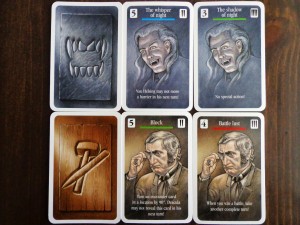
Parts of an Action Card: Top Left = Movement Points, Top Right = Combat Value, Top Middle = Barrier, Bottom = Special Action
Setup
Setup begins by players choosing which side they want to be. Each player gets four energy cubes, ten action cards, and fifteen encounter cards. Each set of cards are unique to either Dracula or Van Helsing. Dracula places their figure on the harbor space and Van Helsing places their figure on the carriage station space. Players then rotate the board so that each player is closest to their figure, if necessary.
The action cards are shuffled separately and placed near their respective players…each player drawing five cards to start with. Each player chooses six of their encounter cards and they are shuffled together. These twelve cards are then laid out on the twelve spaces on the board, randomly. Each player places their remaining encounter cards nearby.
Gameplay
To sum up a player’s turn, they will move their figure, then play an action card.
Moving:
When moving, a player can move their figure as many spaces as they wish, but must keep in mind that they need to play an action card that has at least the movement points listed. If a player moves their figure and does not have an action card with the necessary movement points, they lose one energy cube per extra space.
A player can choose to look at an encounter card after moving to an adjacent space if they wish.
1. If it turns out to be one of their own encounter cards, they can either leave the card as is or swap it out with one of the encounter cards off of the board. After that, they can keep moving if they wish.
2. If it turns out that the encounter card belongs to the enemy, movement ends and the card is resolved. If the card a player finds is one of the five target cards they need (Dracula needs victims, Van Helsing needs coffins), they can take it and keep it face up nearby and then place one of their own encounter cards in its place. Finding an enemy companion (either a vampire or vampire hunter) results in combat. Finding the enemy’s symbol of power means they’ll have to give up an energy cube.
Playing an Action Card:
Whenever a player is done moving (voluntary or not) they must play an action card that satisfies the amount of spaces they moved. If they don’t, they lose an energy cube per movement point short. If combat is involved, they must also consider the combat value of the card they play. Not having enough to satisfy a combat check results in a lost cube.
Action cards may also have a special ability listed on them…a player can choose to perform this action should they wish to. These abilities are unique to the player, giving them advantages in various ways.
After dealing with movement and the possible combat check, that player can move the color barrier indicated on their action card. If it is not on the board yet, they can place it anywhere. Barriers are placed between houses and cannot be crossed, though the board can NEVER be split into two…there must always be a path from one end of the board to the other.
When a player is out of the five action cards they started with, they draw five more. After going through all ten, the deck is reshuffled and five more cards are drawn.
Once a player has moved and played an action card, the other player gets to go. They take turns in this fashion until certain game winning conditions are met.
Game End & Winning
The game ends in victory for a player when they find and take all five of their target cards, or when that player discovers that all of the remaining target cards they need are not on the board but in the enemy’s encounter card deck. (Players can reveal their encounter card decks to each other when they land on each other) A player can lose before these things happen, should they run out of energy cubes.
There’s a bit more to it than what I’ve covered, but that should give you an overview of how the game is played. To see more of the rules in detail, you can check out the manual here:
Editor’s Note: The manual on Rio Grande’s site lists page 8 first…”oops.”
The Review
The learning curve was fairly low and teaching the game to others turned out the be pretty easy. Once players saw how movement and encounter cards intertwined, gameplay became fairly quick. My first instinct before I understood the rules completely was to silently pick out an action card, then move that many spaces intending to play it after moving. However, should I ever enter combat, the card I picked out may not have a high enough combat rating on it for me to win. After a few turns, the kids and I began to understand why the action card is played after moving.
With that understanding of the gameplay mechanics opens up the strategy element. Do you take the risk and move a lot of spaces, possibly limiting your action card choice? What if you run into an enemy companion and have to fight, but all of your high valued combat cards don’t cover your high movement cost? I found in my experiences that players will be required to balance their movement based on the action cards they have in their hand.
Moving and action cards aside, swapping out encounter cards can be a game changer. You will also have the ability to bluff…that is…pretend you’re swapping something out, giving the impression that you moved an opponent’s target card into your encounter deck when you really didn’t. This mechanic really keeps the “other guy” guessing, as they never know what their opponent is finally placing there. Combining a bluff and some well placed barriers can send your opponent on a wild goose chase, if you manage to convey that something is important on a space that isn’t.
Vinnie (11) and I had a lot of fun with Dracula. He isn’t old enough to have an experienced poker face, so I was able to recognize his fake-outs at times. However, when I initiated the bluff, it was fun to watch his mind go, “Knowing that he knows that I know that he knows, he probably put something bad there…however…” I could tell he was enjoying the mystery of revealing each encounter card, regardless. I ended up winning 5-3, but he did an excellent job ensuring that he had at least one target card on the board, lest I run into him and reveal his cards for an instant win. He commented afterwards that he really liked playing, despite how lucky I was in finding his target cards quickly.
This game would be great for couples. The balance would be just about even, except for maybe if you have a partner that bluffs so badly that they aren’t allowed within fifty feet of a Texas Hold’em poker table. All in all, I’m happy with my purchase…if you enjoy games themed for two players, then give this game a look!
Final Verdict: 9/10
—

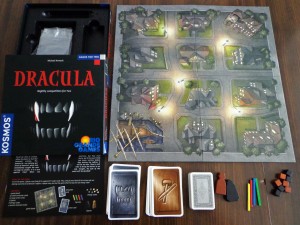
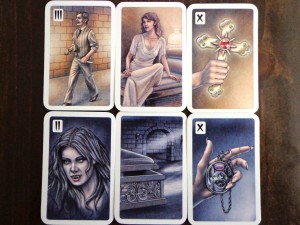
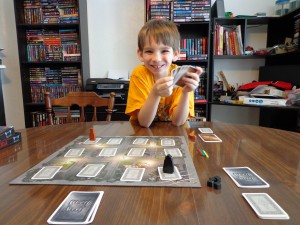
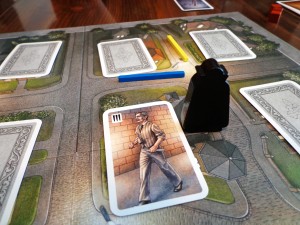
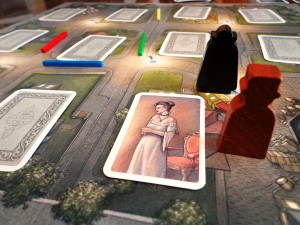
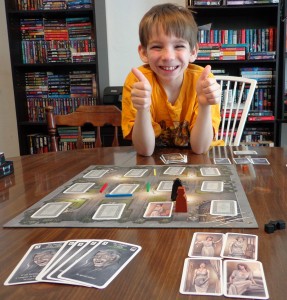
I’m curious where you found this game. I’ve been looking for it for awhile but it’s out of print and no one seems to have a copy.
I get most of my games off of Amazon. Sometimes eBay, if I’m desperate.